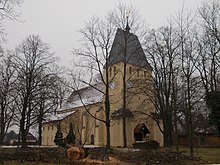Zschortau village church
The Protestant village church Zschortau (also: St. Nicholas) is a late-Gothic hall church in the district Zschortau of Rackwitz in Nordsachsen in Saxony . It belongs to the Zschortau parish in the Zschortau parish of the Evangelical Church in Central Germany and is known for its small baroque organ, which was approved by Johann Sebastian Bach .
History and architecture
The village church dates from the 12th / 13th centuries. Century. The Romanesque rectangular west tower has been preserved from this period . The church was rebuilt around 1500. The nave and choir were considerably enlarged and the sacristy was added. In 1975 the church was restored.
The building is designed as a quarry stone building with a proportion of brick. Large two-lane tracery windows and buttresses characterize the exterior. A two-storey sacristy is attached to the north side of the choir. A reticulated vault with colored ribs and remains of flame and ray paintings at the crossing points completes the interior. The hall is separated from the choir by a pointed arch and from the tower ground floor by a round arch supported by warriors. Simple wooden galleries from 1870 are built in on three sides. A groin vault closes the sacristy.
Furnishing
A carved altar with four wings and framed, delicate, slender figures was probably created in a Halle workshop in 1517 . In the predella , two high reliefs show the birth and adoration of Christ . In the shrine Mary with child and the saints Gertrud and Nikolaus are represented. The wings carry depictions of Saints Antonius , Wolfgang , Andreas , Stephanus , Blasius , Katharina , Anna selbdritt , Barbara , Dorothea , Margarete and another saint in two rows .
The change of the altar shows important paintings by a Leipzig master under the influence of Hans Baldung Grien . Saints George , Mauritius , Sebastian and Christophorus are depicted on the left passive wing, a bishop , James the Elder , Paul , probably Benedict and Bartholomew on the inner wings , and a deacon , Pope Gregory , Ottilia and Apollonia on the right passive wing . The neo-Gothic sandstone baptismal font was created in the second half of the 19th century.
organ
The organ with a richly decorated prospect is a work by Johann Scheibe from the years 1745–1746 with 13 stops on a manual and pedal . It was examined by Johann Sebastian Bach in 1746 and found to be "capable, hardworking and well-built". The original of the acceptance certificate is in the British Museum in London (Add. 33965, fol. 168–169, in the possession of the Consul General Clauss in Leipzig until 1872). In 1870 Eduard Offenhauer moved the organ to the lower gallery and added a backwork with four voices. In 1954, Hermann Eule Orgelbau Bautzen returned the instrument to its original location, rearranged the rear work and added several registers in the main work. In 2000 Eule restored the organ again and restored it to its original condition. The pedal coupler installed in 1870 was retained. The disposition is:
|
|
|||||||||||||||||||||||||||||||||||||||||||||
- Coupling : I / P
- Playing aids : tremulant , calcant pull
literature
- Georg Dehio : Handbook of the German art monuments. Saxony II. The administrative districts of Leipzig and Chemnitz. Deutscher Kunstverlag, Munich / Berlin 1998, ISBN 3-422-03048-4 , p. 1073.
Web links
Individual evidence
- ↑ Prospectus of the organ
- ^ A b Ulrich Dähnert: Historical organs in Saxony . 1st edition. Verlag Das Musikinstrument, Frankfurt am Main 1980, ISBN 3-920112-76-8 , p. 285-286 .
- ↑ Information about the organ on orgbase.nl. Retrieved June 7, 2019 .
Coordinates: 51 ° 28 ′ 41.3 " N , 12 ° 21 ′ 36" E


